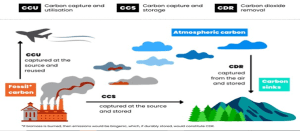IMPACT OF CLIMATE VARIABILITY ON CROP YIELD AND WATER SECURITY IN INDIA
TAG: GS 3: ECOLOGY AND ENVIRONMENT
THE CONTEXT: A recent study, published in the International Journal of Water Resources Development, delves into the intricate relationship between climate variability and its effects on crop yield in India.
EXPLANATION:
- The study offers critical insights into the challenges faced by the agricultural sector, particularly concerning water risks.
- Here, we will explore the nuanced findings and their implications for informed policy decisions.
Climate Variability and Crop Yield Analysis
- Seasonal Impact on Crop Yield:
- The study highlights the significant influence of climate variables like rainfall, evapotranspiration, temperature, and windspeed across different seasons on crop yields.
- Each crop exhibits varying degrees of sensitivity to these climate elements, impacting both the expected yield and yield variability.
- Crop-Specific Responses:
- Crops such as bajra, chickpea, groundnut, rice, and sugarcane demonstrate unique relationships with climate variables.
- For instance, the optimal levels of rainfall and temperature vary for different crops, influencing their yields positively or negatively.
- Risk Assessment and Water Elements:
- Extremes in rainfall, temperature, evapotranspiration, and windspeed are associated with increased yield risks for specific crops.
- Moreover, the study identifies how low or high values of these climatic factors affect crop yield variability.
Water Management Implications and Policy Considerations
- Water Availability and Crop Production:
- Changes in water availability due to climate variations significantly impact crop production.
- To mitigate adverse effects, the study suggests strategies such as diverting surplus water for storage to meet higher water demands during dry seasons.
- Addressing Extreme Climate Events:
- Flooding and droughts caused by extreme rainfall and temperature pose challenges.
- Effective drainage systems and reallocation of water to crops benefiting from irrigation expansion or tolerant to extremes are recommended for better water management.
- Adaptive Strategies:
- The study emphasizes the need for seasonal adaptations and crop-specific measures to sustain long-term water availability.
- It suggests identifying high-tolerant crops and optimizing irrigation diversification based on climate effects.
Policy Implications and Future Directions
- Enhancing Water Management Policies:
- Policy re-evaluation is essential to address the impact of climate change on farm water management.
- Decision-makers need to consider strategies like predictive techniques, diversification of irrigation, and climate-smart agriculture for sustainable outcomes.
- Incorporating Scientific Techniques:
- Implementing modern irrigation techniques and utilizing rainwater effectively can alleviate pressure on groundwater resources.
- Precision farming, scientific water management, and climate-smart agricultural practices are advocated for resilient crop production.
- Inclusive Governance and Farmer Participation:
- Encouraging farmer involvement in water management and aligning policies with region-specific sustainable agricultural practices can yield efficient, equitable, and economically viable outcomes.
Conclusion
- Understanding the intricate effects of climate variability on crop yield and water security is paramount for reevaluating agricultural policies in India.
- This study underscores the need for adaptive strategies, scientific water management, and climate-resilient agriculture to mitigate risks associated with climate change.
- Policy interventions that prioritize sustainable water use and empower local governance can pave the way for resilient agricultural practices and long-term food security in India.
